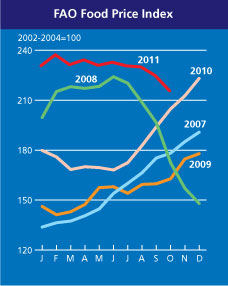A study by Marc F. Bellemare (2011) studies the link between food prices and food-related protests and riots. The study uses the amount of news about food riots as a measure of how widespread protests are and relates these to monthly data on food prices. This creates a relatively short time periods (months rather than years), which increases the accuracy of the relationship. Indeed, if one studies the relationship betweenthe protests in the Middle East that began in January and February with annual data, one would have missed the fact that that they were preceded by very large price increases starting in the fall of 2010. To identify a causal relationship, the study uses natural disasters to explain variation in food prices. Interestingly, the results of this study show that rising food prices lead to increased risk of protests, but that the effect is reverse for food price volatility.
This is from an article in in Sweden’s Axess Magasin by Jesper Roine, of the Stockholm School of Economics.
The original article is in Swedish — the above excerpt is brought to you in part by Google Translate. From the Wiki page for Axess Magasin, I conclude that it’s Sweden’s equivalent of The Atlantic.
